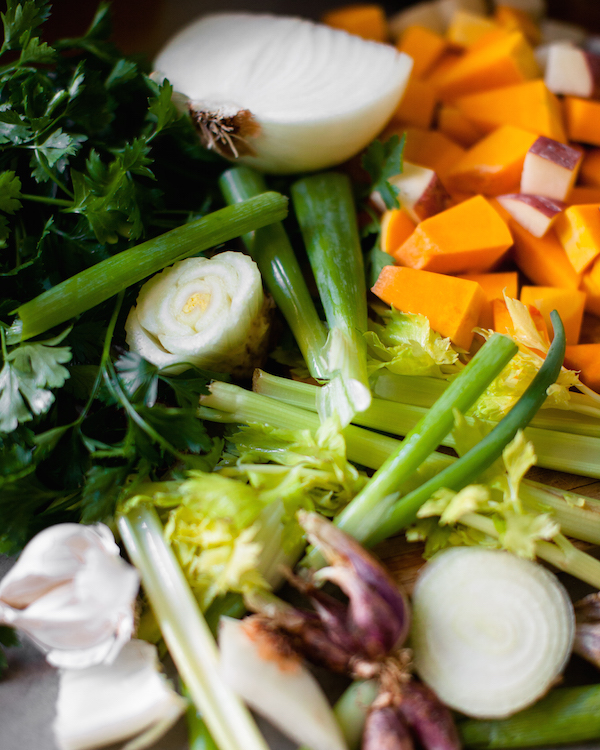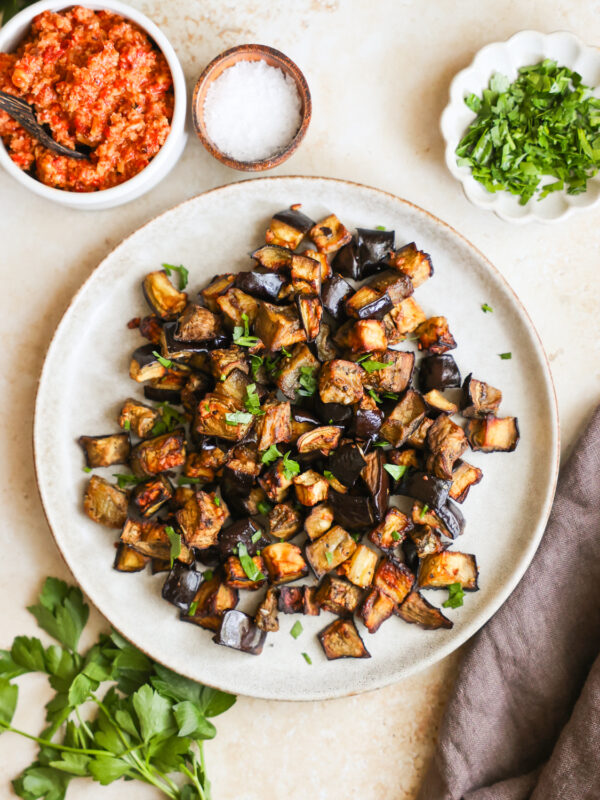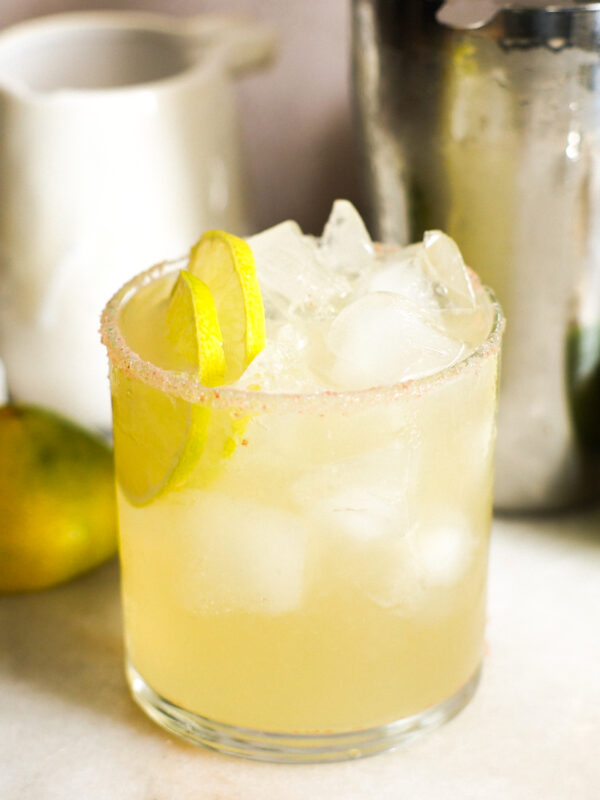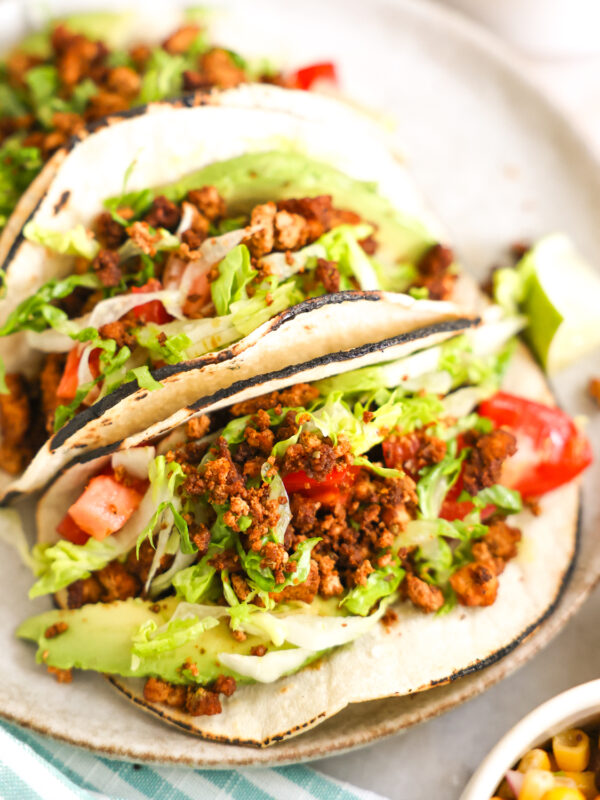This post contains affiliate links. Please see our disclosure policy.

Looks good, right? Click here to PIN this recipe.
If you haven’t been making your own homemade vegetable broth, now is the time to start! It’s easy, nutritious, practically free (if you’re using food scraps), and better for the environment. Even though we compost, I’m always looking for new exciting ways to utilize my food scraps. Making vegetable broth with food scraps is a classic and always timely way to get the most out of your veggies. In this post and video, I’ll show you how you can easily make a very simple vegetable broth, and a more bold mushroom seaweed broth. Both can be used in any recipe that calls for broth. I even like sipping on the mineral rich mushroom broth like a savory tea.

If I don’t make my own vegetable broth, I go through so many jars of Better Than Bouillon paste. I love that stuff so much, but even better is making your own broth. I keep a food storage container in my freezer and add scraps to it as I cook throughout the week. When that container gets full, it’s time to boil the scraps for broth. It’s really that simple! Boil, strain, and done.
Not every vegetable scrap is suitable for veggie broth, however. You want to stick to clean tops, bottoms, and peels from non-starchy veggies like onions, leeks, garlic, celery, carrots, mushrooms, tomatoes, herbs, and greens. Don’t plan on making veggie broth with the starchy bits from your potatoes and sweet potatoes. Compost those guys 😉
My favorite veggie broth is one that is made with plenty of mushroom bottoms. Mushrooms can be pricey, so I’m extra intentional about using every centimeter of this nutrient dense food. You can make a mushroom-only broth, or mix them with other veggie scraps. Get creative with your veggie broth mixes. You can even experiment with adding flavor boosters like tomato paste, nutritional yeast, soy sauce, and dried herbs. But for now, I’m leaving you with two very simple and delicious recipes to get started. Let me know if you’d like to see more vegetable broth recipes in the comments below!
Save now, cook later.

Mushroom Stock
Ingredients
- 2 cups mushroom bottoms or pieces, try to use more flavorful mushrooms like maitake, shiitake, porcini, or oyster
- 1 tbsp dulse seaweed flakes, or 1 piece of whole dulse
- 1 tbsp wakame seaweed, or 2 sheets of wild Atlantic wakame called alaria
- 8 cups water
Instructions
- Combine all the ingredients in a large pot and bring it to a boil over high heat.
- Reduce the heat to low or medium-low and bring the mixture to a simmer. Cover the pot and simmer for 30 minutes.
- Cool the vegetable stock in the pot before straining it into glass jars or storage containers.
- If you liked this recipe, please take a moment to rate it. Thank you!
Notes
- Refrigeration: Cool the broth completely to room temperature before transferring it to glass bottles and refrigerating for up to 1 week.
- Freezing: For extended storage time, freeze it in freezer-safe containers or a zip-top bag for up to 6 months. For easy single-use access, you can also freeze the broth in ice cube trays before moving the frozen cubes to the freezer-safe bag.
- Reheating: Reheat broth from refrigerated or frozen on the stovetop over low or medium-low heat until your desired temperature. It also can be warmed in the microwave.
- Clean the mushrooms well. These fungi tend to capture dirt and residue, which can cloud up or add unpleasant flavor to the stock. Clean them well with a damp cloth or mushroom brush before using.
- Season with salt (or soy sauce)! If desired, add 1-2 teaspoons of fine sea salt to taste or a few tablespoons of soy sauce or tamari to make seasoned mushroom broth.
- Save on waste. Though you can make this recipe with fresh mushrooms, it’s also a great way to use up food scraps! Add the mushroom stalks to a container in the freezer as you cook throughout the week; once it’s full, boil the mushroom pieces for broth!

PIN this recipe to save it for later!
Save now, cook later.

Vegetable Stock
Video
Ingredients
- 4-6 cups vegetable scraps, From clean, non-starchy vegetables like carrots, celery, onions, leeks, herbs, garlic, green onions, tomatoes, mushrooms and mushroom bottoms, and greens
- 1-2 dried bay leaves
- 1-2 tsp dried thyme
- 8-10 cups water
Instructions
- Combine all the ingredients in a large pot and bring to a boil over high heat.
- Reduce the heat to low or medium-low and bring to a simmer. Cover the pot and cook for 30 minutes.
- Carefully strain the broth through a wire mesh strainer or cheesecloth. Cool the vegetable stock in the pot or a heat-safe shallow mixing bowl before storing in glass containers.
Notes
- Refrigeration: Cool the broth completely to room temperature before transferring it to glass containers and refrigerating it for up to 7 days.
- Freezing: The broth can also be frozen in a freezer-safe container or zip-top bag for up to 6 months. Defrost it in a large bowl overnight in the refrigerator or over low heat on the stovetop.
- Reheating: Warm it in the microwave or on the stovetop over medium heat until hot.
- Using fresh vegetables. You can also make this vegetable stock recipe with fresh vegetables. I recommend 4-6 cups of cleaned and chopped onions, carrots, and celery; 3-4 peeled and crushed garlic cloves, a handful of fresh herbs, 2 dried bay leaves, and chopped leeks or fennel fronds.
- Do not use starchy vegetable scraps. The starch in vegetables such as sweet or white potatoes, parsnips, or peas will release into the broth, making it cloudy or thickening it.
- Drain well. For clear, filtered vegetable broth, drain the cooked veggie mixture over a fine mesh strainer. If your veggie scraps are small, line the strainer with cheesecloth to catch the pieces.
- Season with salt if desired. This veggie stock recipe is not salted, but you can season it with 1-2 teaspoons of fine sea salt if preferred.










LOVED THIS VIDEO, RECIPE AND HER PRESENTATION. I’m a broth fan & nerd and have done my version also. I also incorporate previously done broths of all flavors (mushroom, chicken, beef, etc) instead of tap water, to incorporate into random soups and creations, and even a couple of envelopes of unflavored gelatin towards the end of “simmer” for it’s contribution to body needs. Even reduced starchy potato boiling water to use with my homemade bread. Video and her wonderful presentation skills can assist in our good health and better living. Just my opinion!
Just found your site and can’t wait to try Mushroom Broth, Watermelon Rind Relish,
Vegetable Broth. My husband has a bad kidney and can’t have more than, 1,500 mg of salt a day…….that is any kind of salt. Sugar less than 13gm in things because of his diabetic. It has been hard to cook for the last year and find we are eating the same things all the time. Can you give me any ideas?? It seems to me that without Salt or Sugar you lose a lot of taste. Do NOT GIVE MY EMAIL OUT TO ANYONE or I will block them. A friend told me about you… https://sweetpotatosoul.com/wprm_print/6878